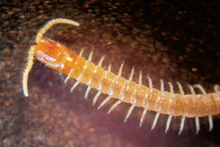| Mecistocephalidae | |
|---|---|

| |
| Tygarrup javanicus | |
| Scientific classification | |
| Domain: | Eukaryota |
| Kingdom: | Animalia |
| Phylum: | Arthropoda |
| Subphylum: | Myriapoda |
| Class: | Chilopoda |
| Order: | Geophilomorpha |
| Suborder: | Placodesmata Bollman, 1893 |
| Family: | Mecistocephalidae (Bollman, 1893) |
| Genera | |
|
See text | |
Mecistocephalidae is a monophyletic family of centipedes in the order Geophilomorpha. It is the only family in the suborder Placodesmata. Most species in this family live in tropical or subtropical regions, but some occur in temperate regions. This family is the third most diverse in the order Geophiliomorpha (after Geophilidae and Schendylidae), with about 170 species, including about 130 species in the genus Mecistocephalus.
Description
Species of this family are characterized by an elongated head with lateral margins converging backwards; first maxillae with relatively elongate coxosternite, and coxal projections much wider than telopodites, both ending with a distinctly hyaline part; second maxillae with small simple claws; elongate forcipular coxosternite with pleurites projecting anteriorly into scapular points and displaced dorsally so that the coxopleural sutures run anteriorly on the dorsal side; metatergites of the posterior part of the trunk distinctly longer than those on the anterior part.
This family differs from all other geophilomorphs insofar as the number of segments in mecistocephalids is generally fixed within each species and the same for each sex. The family includes centipedes with odd numbers of leg-bearing segments ranging from as few as 41 to as many as 101. A majority of the species in the genus Mecistocephalus have 49 pairs of legs, a majority so large that most species in the family Mecistocephalidae have 49 leg pairs, even though only one mecistocephalid species (Proterotaiwanella sculptulata) outside the genus Mecistocephalus shares this number.
The next most common numbers are 45 leg pairs, found in most species in the genus Tygarrup as well as in species distributed among five other genera, and 41 leg pairs, found in all species in the genera Agnostrup, Anarrup, Arrup, Nannarrup, and Partygarrupius as well as in two species of Dicellophilus; fewer mecistocephalid species have 47 leg pairs (e.g., Mecistocephalus angusticeps and M. tahitiensis) or 51 leg pairs (e.g., M. evansi and M. lifuensis), found only in the genus Mecistocephalus, and the other remaining numbers are even more rare (e.g., 43 leg pairs, found in Dicellophilus carniolensis).
Intraspecific variation in the number of leg-bearing segments within each sex has been recorded among the mecistocephalid species with the greatest number of legs: Mecistocephalus diversisternus, which has 57 or 59 leg pairs, M. japonicus, which has 63 or 65 leg pairs, and M. microporus, which has odd numbers of leg pairs ranging from 93 to 101. Other mecistocephalid species with many legs are known from samples too small to provide persuasive evidence of intraspecific invariance (e.g., M. cyclops, with 57 leg pairs in the only known specimen). The mecistocephalid species Krateraspis sselivanovi has 53 leg pairs without intraspecific variation, which appears to be the maximum number evidently fixed by species in the class Chilopoda.
Genera
The family contains the following genera:
- Agnostrup
- Anarrup
- Arrup
- Dicellophilus
- Krateraspis
- Mecistocephalus
- Nannarrup
- Partygarrupius
- Proterotaiwanella
- Takashimaia
- Tygarrup
References
- ^ Bonato, Lucio (2014). "Phylogeny of Geophilomorpha (Chilopoda) inferred from new morphological and molecular evidence". Cladistics. The International Journal of the Willi Hennig Society. 30 (5): 485–507. doi:10.1111/cla.12060. PMID 34794246. S2CID 86204188. Retrieved 27 October 2021.
- "Placodesmata". Integrated Taxonomic Information System. itis.gov. Retrieved 4 November 2021.
- "Placodesmata". www.gbif.org. GBIF. Retrieved 2021-12-17.
- ^ Bonato, Lucio; Foddai, Donatella; Minelli, Alessandro (2003). "Evolutionary trends and patterns in centipede segment number based on a cladistic analysis of Mecistocephalidae (Chilopoda: Geophilomorpha): Evolution of segment number in Mecistocephalidae". Systematic Entomology. 28 (4): 539–579. doi:10.1046/j.1365-3113.2003.00217.x.
- Tuf, Ivan Hadrián; Mock, Andrej; Dvořák, Libor (2018-06-01). "An exotic species spreads through Europe: Tygarrup javanicus (Chilopoda: Geophilomorpha: Mecistocephalidae) is reported from the Slovakia and the Czech Republic". Journal of Asia-Pacific Entomology. 21 (2): 560–562. doi:10.1016/j.aspen.2018.03.004. ISSN 1226-8615. S2CID 89794909.
- ^ Bonato, Lucio; Edgecombe, Gregory D.; Zapparoli, Marzio (2011). "Chilopoda – Taxonomic overview". In Minelli, Alessandro (ed.). The Myriapoda. Volume 1. Leiden: Brill. pp. 363–443. ISBN 978-90-04-18826-6. OCLC 812207443.
{{cite book}}: CS1 maint: date and year (link) - ^ Minelli, Alessandro; Bortoletto, Stefano (1988-04-01). "Myriapod metamerism and arthropod segmentation". Biological Journal of the Linnean Society. 33 (4): 323–343 . doi:10.1111/j.1095-8312.1988.tb00448.x. ISSN 0024-4066.
- Bonato, L.; Minelli, A. (2004). "The centipede genus Mecistocephalus Newport 1843 in the Indian Peninsula (Chilopoda Geophilomorpha Mecistocephalidae)". Tropical Zoology. 17 (1): 15–63. doi:10.1080/03946975.2004.10531198. ISSN 0394-6975. S2CID 85304657.
- ^ Dyachkov, Yurii V.; Bonato, Lucio (2022-04-14). "Morphology and distribution of the Middle Asian centipede genus Krateraspis Lignau, 1929 (Chilopoda, Geophilomorpha, Mecistocephalidae)". ZooKeys (1095): 143–164. doi:10.3897/zookeys.1095.80806. ISSN 1313-2970. PMC 9023436. PMID 35836682.
- ^ Bonato, Lucio; Dányi, László; Minelli, Alessandro (2010). "Morphology and phylogeny of Dicellophilus, a centipede genus with a highly disjunct distribution (Chilopoda: Mecistocephalidae)". Zoological Journal of the Linnean Society. 158 (3): 501–532. doi:10.1111/j.1096-3642.2009.00557.x.
- Evans, W. Edgar; Brolemann, Henry W. (1923). "VI.—Myriapods collected in Mesopotamia and N.W. Persia". Proceedings of the Royal Society of Edinburgh. 42: 54–74. doi:10.1017/S0370164600023841. ISSN 0370-1646.
- Minelli, Alessandro (2020). "Arthropod Segments and Segmentation – Lessons from Myriapods, and Open Questions" (PDF). Opuscula Zoologica (Budapest). 51(S2): 7–21 . doi:10.18348/opzool.2020.S2.7. S2CID 226561862.
- Bonato, Lucio; Minelli, Alessandro (2010). "The geophilomorph centipedes of the Seychelles (Chilopoda: Geophilomorpha)" (PDF). Phelsuma. 18: 9–38.
- Dyachkov, Yu. V. (2019). "New data on the family Mecistocephalidae Bollman, 1893 (Chilopoda: Geophilomorpha) from Middle Asia". Arthropoda Selecta. 28 (1): 368–373. doi:10.15298/arthsel.28.3.02. ISSN 0136-006X. S2CID 216530363.
- Minelli, Alessandro; Chagas-Júnior, Amazonas; Edgecombe, Gregory D. (2009). "Saltational evolution of trunk segment number in centipedes". Evolution & Development. 11 (3): 318–322 . doi:10.1111/j.1525-142X.2009.00334.x. PMID 19469859. S2CID 40909871.
- "ITIS - Report: Mecistocephalidae". www.itis.gov. Retrieved 2022-12-28.